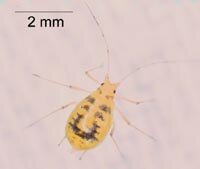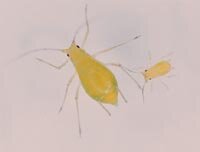| The International Camellia Society [ TOPICS  ] [Pests & Diseases ] [Pests & Diseases  ] [ Aphids ] ] [ Aphids ] |
Aphids
by Klaus Peper
![]()
  Aphids create no serious problem in Camellias, however, if unattended, they can do considerable damage to the plant. They occur on new shoots, are easily detected and can be destroyed mechanically by your fingers, or by the application of water or a mixture of water with fluid soap. Aphids can multiply at an incredibly high rate, thus be prepared, in case of infection, to watch your plants at regular intervals. Aphids create no serious problem in Camellias, however, if unattended, they can do considerable damage to the plant. They occur on new shoots, are easily detected and can be destroyed mechanically by your fingers, or by the application of water or a mixture of water with fluid soap. Aphids can multiply at an incredibly high rate, thus be prepared, in case of infection, to watch your plants at regular intervals.
|
